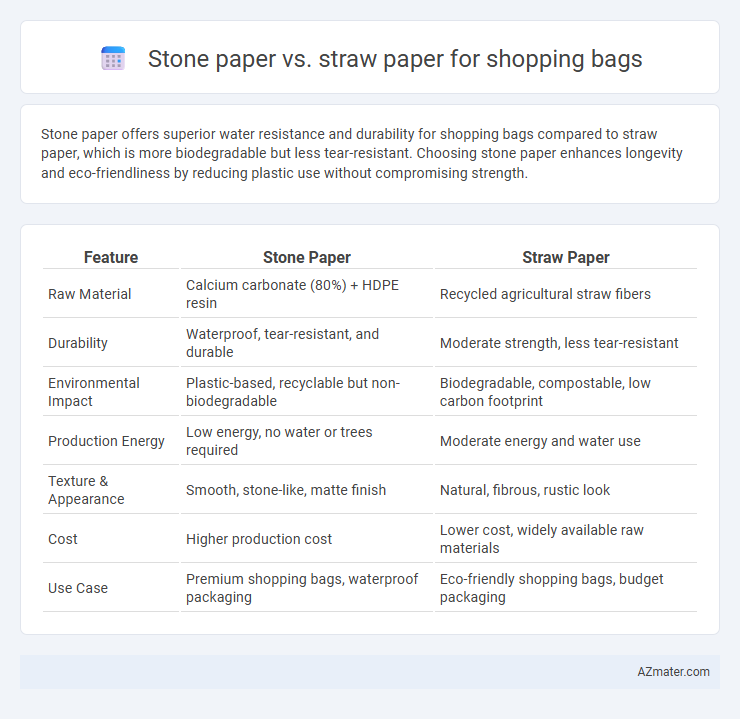Stone paper offers superior water resistance and durability for shopping bags compared to straw paper, which is more biodegradable but less tear-resistant. Choosing stone paper enhances longevity and eco-friendliness by reducing plastic use without compromising strength.
Table of Comparison
| Feature | Stone Paper | Straw Paper |
|---|---|---|
| Raw Material | Calcium carbonate (80%) + HDPE resin | Recycled agricultural straw fibers |
| Durability | Waterproof, tear-resistant, and durable | Moderate strength, less tear-resistant |
| Environmental Impact | Plastic-based, recyclable but non-biodegradable | Biodegradable, compostable, low carbon footprint |
| Production Energy | Low energy, no water or trees required | Moderate energy and water use |
| Texture & Appearance | Smooth, stone-like, matte finish | Natural, fibrous, rustic look |
| Cost | Higher production cost | Lower cost, widely available raw materials |
| Use Case | Premium shopping bags, waterproof packaging | Eco-friendly shopping bags, budget packaging |
Introduction to Alternative Shopping Bag Materials
Stone paper and straw paper offer sustainable alternatives to traditional plastic shopping bags, reducing environmental impact through biodegradable and renewable materials. Stone paper, made from calcium carbonate bonded with non-toxic resin, provides durability, water resistance, and tear strength without relying on wood pulp. Straw paper, derived from agricultural waste fibers, combines eco-friendliness with compostability, making it a viable option for eco-conscious retailers seeking to minimize plastic waste.
What is Stone Paper?
Stone paper is a sustainable material made from calcium carbonate bonded with high-density polyethylene, offering a waterproof and tear-resistant alternative to traditional paper. Unlike straw paper, which is derived from agricultural waste, stone paper requires no water or trees in its production, significantly reducing environmental impact. Its durability and eco-friendly properties make it an ideal choice for shopping bags seeking strength and sustainability.
What is Straw Paper?
Straw paper is an eco-friendly material made primarily from agricultural residues like wheat, rice, or barley straw, offering a sustainable alternative to wood pulp paper. Its production process uses less water and energy while reducing deforestation, making it ideal for biodegradable shopping bags. Compared to stone paper, straw paper has a natural texture and is fully compostable, aligning with environmentally conscious consumer preferences.
Production Processes: Stone Paper vs Straw Paper
Stone paper production involves crushing limestone into a fine powder, which is mixed with non-toxic resin and compressed into sheets, eliminating the need for water and trees. Straw paper manufacturing repurposes agricultural byproducts like wheat or rice straw, pulping fibers with water and chemicals before forming sheets, relying heavily on water and energy consumption. Compared to straw paper, stone paper offers a more sustainable production process with lower water usage and reduced reliance on organic raw materials.
Environmental Impact Comparison
Stone paper and straw paper offer eco-friendly alternatives to traditional plastic for shopping bags, with stone paper made from calcium carbonate and a small amount of non-toxic resin, resulting in a waterproof, durable product that requires no trees and uses less water in production. Straw paper, derived from agricultural waste like wheat or rice straw, reduces reliance on wood pulp, lowers greenhouse gas emissions, and promotes circular economy by repurposing crop residues. The environmental impact comparison favors straw paper for biodegradability and compostability, while stone paper excels in durability and water resistance but lacks biodegradability; both significantly reduce deforestation and resource consumption compared to conventional paper and plastic bags.
Durability and Strength Assessment
Stone paper offers superior durability and tensile strength compared to straw paper, making it more resistant to tearing and wear in shopping bag applications. Its synthetic composition provides water resistance and longevity under repeated use, whereas straw paper, derived from agricultural waste, tends to be less robust and more susceptible to moisture damage and degradation over time. The higher durability and strength of stone paper enhance shopping bag performance, ensuring better load-bearing capacity and extended usability.
Printing and Design Compatibility
Stone paper offers exceptional printing clarity and vibrant color reproduction due to its smooth, non-porous surface, enhancing the visual appeal of shopping bags. Straw paper, while eco-friendly, tends to have a more textured surface that may absorb inks unevenly, resulting in less sharp prints and muted colors. For designs requiring intricate details and bold graphics, stone paper provides superior compatibility and durability compared to straw paper.
Cost Analysis: Stone Paper vs Straw Paper
Stone paper typically has higher initial production costs due to its synthetic minerals and manufacturing process, but lower long-term costs from durability and water resistance, reducing replacement frequency. Straw paper benefits from lower raw material expenses as it utilizes agricultural waste, making it cost-effective and eco-friendly, though it may incur higher maintenance or replacement costs in high-moisture environments. When comparing stone paper vs straw paper for shopping bags, businesses must balance upfront investment against durability and environmental impact to determine overall cost efficiency.
Biodegradability and Recycling Options
Stone paper shopping bags are made from calcium carbonate and resin, making them water-resistant but less biodegradable, as they can take centuries to break down. Straw paper bags, derived from agricultural residues, offer superior biodegradability and compostability, decomposing within months under natural conditions. Recycling options for straw paper bags are more accessible since they integrate seamlessly into conventional paper recycling streams, whereas stone paper requires specialized recycling processes due to its unique composition.
Choosing the Right Material for Shopping Bags
Stone paper offers superior water resistance and durability compared to straw paper, making it ideal for shopping bags that require strength and longevity. Straw paper, made from agricultural waste, provides an eco-friendly and biodegradable option but may lack the robustness needed for heavier loads. Choosing between these materials depends on balancing environmental impact with functional requirements such as weight capacity and weather resistance.

Infographic: Stone paper vs Straw paper for Shopping bag
 azmater.com
azmater.com